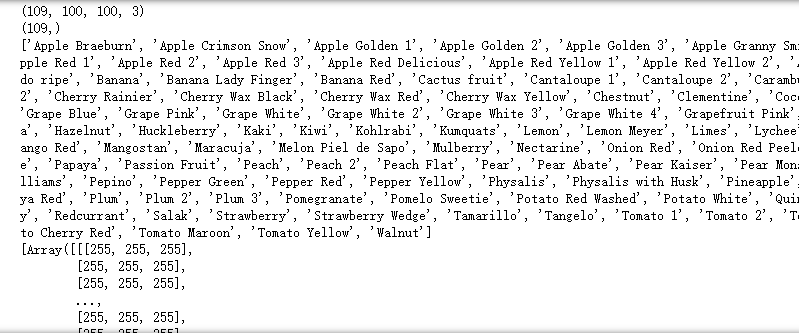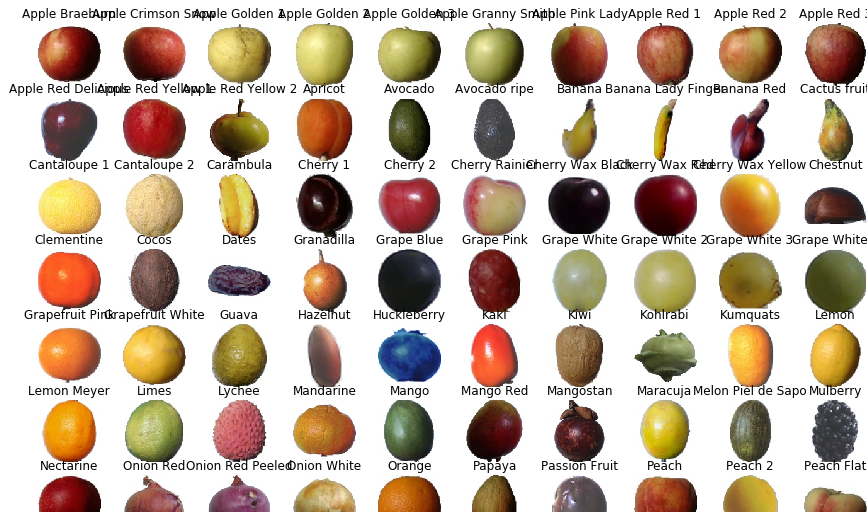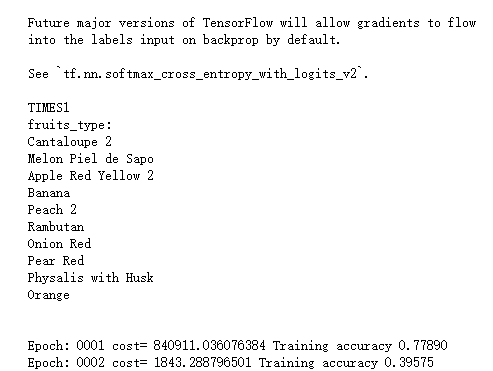吴裕雄 python 神经网络——TensorFlow 卷积神经网络水果图片识别
#-*- coding:utf- -*- import time
import keras
import skimage
import numpy as np
import tensorflow as tf
import matplotlib.image as img from scipy import ndimage
from skimage import color, data, transform %matplotlib inline
#设置文件目录
Training = r'F:\\data\\fruits-360\\Training'
Test = r'F:\\data\\fruits-360\\Test'
import os
from natsort import natsorted #获取每类水果中的第五张图像
def load_print_img(root):
print_img = []
print_label = []
#遍历水果种类目录
for i in range(len(os.listdir(root))):
child1 = os.listdir(root)[i]
child2 = os.listdir(os.path.join(root, child1))
#对第二层目录进行自然数排序,os.listder默认为str排序
child2 = natsorted(child2)
#取出每类的第五张图像
path = os.path.join(root, child1, child2[])
if(path.endswith('.jpg')):
print_img.append(skimage.data.imread(path))
print_label.append(child1)
return print_img, print_label print_img, print_label = load_print_img(Test)
print(np.shape(print_img))
print(np.shape(print_label))
print(print_label)
print(print_img)

import matplotlib.pyplot as plt
from IPython.core.pylabtools import figsize #打印每类水果的第五张图像
def print_fruit(print_img, print_label, size) :
plt.figure(figsize(size, size))
for i in range(len(print_img)):
#图像输出格式为11行10列
plt.subplot(, ,(i+))
#打印图像
plt.imshow(print_img[i])
#打印水果种类
plt.title(format(print_label[i]))
plt.axis('off')
plt.show() print_img, print_label = load_print_img(Test)
#打印水果
print_fruit(print_img, print_label, )

import random #随机获取水果种类
def get_random_fruits(root, n_classes):
#创建一个1到水果种类总数的list
fruits = []
for i in range(len(os.listdir(root))):
fruits.append(i)
#随机获取n_classes个随机不重复的水果种类
random_fruits = random.sample(fruits, n_classes)
return random_fruits
#获取随机抽取的10类水果的图像
def load(root, random_fruits):
#存放图像
image_data = []
#存放标签
image_label = []
#存放图像标签码
num_label = []
#遍历水果类型
for i in range(len(random_fruits)):
#第一层子目录(水果种类)
child1 = os.listdir(root)[i]
#第二层子目录(水果图像)
child2 = os.listdir(os.path.join(root, child1))
#对第二层目录进行自然数排序,os.listder默认为str排序
child2 = natsorted(child2)
#遍历水果图像
for j in range(len(child2)):
#结合第一二层子目录
path = os.path.join(root, child1, child2[j])
#只读取'.jpg'文件(文件后缀是否为'.jpg')
if(path.endswith('.jpg')):
#把文件读取为图像存入image_data
image_data.append(skimage.data.imread(path))
#储存第一层子目录文件名(即水果名)
image_label.append(child1)
#把第一层子目录文件名的下标作为水果类型的编码
num_label.append(i)
#把水果类型编码转换为one_hot编码
num_label = keras.utils.to_categorical(num_label, len(random_fruits))
#print("图片数:{0}, 标签数:{1}".format(len(image_data), len(os.listdir(root))) #输出图片和标签数
return image_data, image_label, num_label
#裁剪图像
def crop(image_data):
crop_data = []
for i in image_data:
#把图像转换成32*32的格式
I_crop = skimage.transform.resize(i, (, ))
#把转换后的图像放入Icrop_data
crop_data.append(I_crop)
return crop_data
def fruits_type(random_fruits):
print('fruits_type:')
for i in random_fruits:
print(os.listdir(Training)[i])
#定义水果种类数
n_classes =
#batch_size = #定义块的大小
#batch_num = int(np.array(crop_img).shape[]/batch_size) #计算取块的次数
#申请四维占位符,数据类型为float32
x = tf.placeholder(tf.float32,[None, , , ])
#申请二维占位符,数据累型为float32
y = tf.placeholder(tf.float32,[None, n_classes])
#申请一维占位符,数据类型为float32
keep_prob = tf.placeholder(tf.float32)
#epochs= #训练次数
#每个神经元保留的概率
dropout=0.75
#卷积核大小
k_size = Weights = {
"conv_w1" : tf.Variable(tf.random_normal([k_size, k_size, , ]), name = 'conv_w1'),
"conv_w2" : tf.Variable(tf.random_normal([k_size, k_size, , ]), name = 'conv_w2'),
#"conv_w3" : tf.Variable(tf.random_normal([k_size, k_size, , ]), name = 'conv_w3'), \
"den_w1" : tf.Variable(tf.random_normal([int(*//*), ]), name = 'dev_w1'),
"den_w2" : tf.Variable(tf.random_normal([, ]), name = 'den_w2'),
"den_w3" : tf.Variable(tf.random_normal([, n_classes]), name = 'den_w3')
} bias = {
"conv_b1" : tf.Variable(tf.random_normal([]), name = 'conv_b1'),
"conv_b2" : tf.Variable(tf.random_normal([]), name = 'conv_b2'),
#"conv_b3" : tf.Variable(tf.random_normal([]), name = 'conv_b3'), \
"den_b1" : tf.Variable(tf.random_normal([]), name = 'den_b1'),
"den_b2" : tf.Variable(tf.random_normal([]), name = 'den_b2'),
"den_b3" : tf.Variable(tf.random_normal([n_classes]), name = 'den_b3')
} def conv2d(x,W,b,stride=):
x=tf.nn.conv2d(x,W,strides=[,stride,stride,],padding="SAME")
x=tf.nn.bias_add(x,b)
return tf.nn.relu(x) def maxpool2d(x,stride=):
return tf.nn.max_pool(x,ksize=[,stride,stride,],strides=[,stride,stride,],padding="SAME")
def conv_net(inputs, W, b, dropout):
## convolution layer
## 输入32**3的数据,输出16**64的数据
conv1 = conv2d(x, W["conv_w1"], b["conv_b1"])
conv1 = maxpool2d(conv1, )
tf.summary.histogram('ConvLayer1/Weights', W["conv_w1"])
tf.summary.histogram('ConvLayer1/bias', b["conv_b1"])
## convolution layer2
## 输入16**64的数据,输出8**128的数据
conv2 = conv2d(conv1, W["conv_w2"], b["conv_b2"])
conv2 = maxpool2d(conv2, )
tf.summary.histogram('ConvLayer2/Weights', W["conv_w2"])
tf.summary.histogram('ConvLayer2/bias', b["conv_b2"])
## convolution layer3
#conv3 = conv2d(conv2, W["conv_w3"], b["conv_b3"])
#conv3 = maxpool2d(conv3, )
#tf.summary.histogram('ConvLayer3/Weights', W["conv_w3"])
#tf.summary.histogram('ConvLayer3/bias', b["conv_b3"])
## flatten
## 把数据拉伸为长度为8**128的一维数据
flatten = tf.reshape(conv2,[-, W["den_w1"].get_shape().as_list()[]])
## dense layer1
## 输入8192*1的数据,输出1024*1的数据
den1 = tf.add(tf.matmul(flatten, W["den_w1"]), b["den_b1"])
den1 = tf.nn.relu(den1)
den1 = tf.nn.dropout(den1, dropout)
tf.summary.histogram('DenLayer1/Weights', W["den_w1"])
tf.summary.histogram('DenLayer1/bias', b["den_b1"])
## dense layer2
## *1的数据,输出512*1的数据
den2 = tf.add(tf.matmul(den1, W["den_w2"]), b["den_b2"])
den2 = tf.nn.relu(den2)
den2 = tf.nn.dropout(den2, dropout)
tf.summary.histogram('DenLayer2/Weights', W["den_w2"])
tf.summary.histogram('DenLayer2/bias', b["den_b2"])
## out
## *1的数据,输出n_classes*1的数据
out = tf.add(tf.matmul(den2, W["den_w3"]), b["den_b3"])
tf.summary.histogram('DenLayer3/Weights', W["den_w3"])
tf.summary.histogram('DenLayer3/bias', b["den_b3"])
return out
pred=conv_net(x,Weights,bias,keep_prob)
cost=tf.reduce_mean(tf.nn.softmax_cross_entropy_with_logits(logits=pred,labels=y))
tf.summary.histogram('loss', cost)
optimizer=tf.train.AdamOptimizer(0.01).minimize(cost)
correct_pred=tf.equal(tf.argmax(pred,),tf.argmax(y,))
accuracy=tf.reduce_mean(tf.cast(correct_pred,tf.float32))
merged=tf.summary.merge_all() def train_and_test(train_x, train_y, test_x, test_y, epochs, batch_size, times = ) :
# 初始化全局变量
init=tf.global_variables_initializer()
start_time = time.time()
with tf.Session() as sess:
sess.run(init)
# 把需要可视化的参数写入可视化文件
writer=tf.summary.FileWriter('F:\\data\\fruits-360\\tensorboard\\Fruit_graph' + str(times), sess.graph)
for i in range(epochs):
batch_num = int(np.array(train_x).shape[]/batch_size)
sum_cost =
sum_acc =
for j in range(batch_num):
batch_x = get_data(train_x, batch_size, j)
batch_y = get_data(train_y, batch_size, j)
sess.run(optimizer, feed_dict={x:batch_x,y:batch_y,keep_prob:0.75})
loss,acc = sess.run([cost,accuracy],feed_dict={x:batch_x,y:batch_y,keep_prob: .})
sum_cost += loss
sum_acc += acc
result=sess.run(merged,feed_dict={x:batch_x, y:batch_y, keep_prob:0.75})
writer.add_summary(result, i)
arg_cost = sum_cost/batch_num
arg_acc = sum_acc/batch_num
print("Epoch:", '%04d' % (i+),"cost=", "{:.9f}".format(arg_cost),"Training accuracy","{:.5f}".format(arg_acc))
end_time = time.time()
print('Optimization Completed')
print('Testing Accuracy:',sess.run(accuracy,feed_dict={x:test_x, y:test_y,keep_prob: }))
print('Total processing time:',end_time - start_time) for i in range():
random_fruits = get_random_fruits(Training, n_classes)
img_data, img_label, num_label = load(Training, random_fruits)
crop_img = crop(img_data)
test_data, test_label, test_num_label = load(Test, random_fruits)
crop_test = crop(test_data)
print("TIMES"+str(i+))
fruits_type(random_fruits)
print("\n")
train_and_test(crop_img, num_label, crop_test, test_num_label, , , (i+))
print("\n\n\n")

吴裕雄 python 神经网络——TensorFlow 卷积神经网络水果图片识别的更多相关文章
- 吴裕雄--天生自然 Tensorflow卷积神经网络:花朵图片识别
import os import numpy as np import matplotlib.pyplot as plt from PIL import Image, ImageChops from ...
- 吴裕雄 python 神经网络——TensorFlow 卷积神经网络手写数字图片识别
import os import tensorflow as tf from tensorflow.examples.tutorials.mnist import input_data INPUT_N ...
- Tensorflow卷积神经网络
卷积神经网络(Convolutional Neural Network, CNN)是一种前馈神经网络, 在计算机视觉等领域被广泛应用. 本文将简单介绍其原理并分析Tensorflow官方提供的示例. ...
- Tensorflow卷积神经网络[转]
Tensorflow卷积神经网络 卷积神经网络(Convolutional Neural Network, CNN)是一种前馈神经网络, 在计算机视觉等领域被广泛应用. 本文将简单介绍其原理并分析Te ...
- 深度学习原理与框架-Tensorflow卷积神经网络-cifar10图片分类(代码) 1.tf.nn.lrn(局部响应归一化操作) 2.random.sample(在列表中随机选值) 3.tf.one_hot(对标签进行one_hot编码)
1.tf.nn.lrn(pool_h1, 4, bias=1.0, alpha=0.001/9.0, beta=0.75) # 局部响应归一化,使用相同位置的前后的filter进行响应归一化操作 参数 ...
- TensorFlow 卷积神经网络实用指南 | iBooker·ApacheCN
原文:Hands-On Convolutional Neural Networks with TensorFlow 协议:CC BY-NC-SA 4.0 自豪地采用谷歌翻译 不要担心自己的形象,只关心 ...
- 吴裕雄 python 神经网络——TensorFlow 使用卷积神经网络训练和预测MNIST手写数据集
import tensorflow as tf import numpy as np from tensorflow.examples.tutorials.mnist import input_dat ...
- 吴裕雄 python神经网络 水果图片识别(4)
# coding: utf-8 # In[1]:import osimport numpy as npfrom skimage import color, data, transform, io # ...
- 吴裕雄 python神经网络 水果图片识别(2)
import osimport numpy as npimport matplotlib.pyplot as pltfrom skimage import color,data,transform,i ...
随机推荐
- POJ 1141 经典DP 轨迹打印
又几天没写博客了,大二的生活实在好忙碌啊,开了五门专业课,每周都是实验啊实验啊实验啊....我说要本月刷够60题,但好像完不成了,也就每天1题的样子.如今写动规还是挺有条理的,包括这道需要打印轨迹,其 ...
- SQL基础教程(第2版)第6章 函数、谓词、CASE表达式:6-3 CASE表达式
● 虽然CASE表达式中的ELSE子句可以省略,但为了让SQL语句更加容易理解,还是希望大家不要省略. ● CASE表达式中的END不能省略. ● 使用CASE表达式能够将SELECT语句的结果进行组 ...
- 怎么调出原生态launcher
adb shell am start -n com.android.launcher3/.Launcher
- TCP连接为什么三次握手四次挥手
前几天面试某电商被问住了,问的很细,我就说了说连接过程,必然凉凉.在csdn上找了一篇很详细的博客.https://blog.csdn.net/hyg0811/article/details/1023 ...
- @ConfigurationProperties的几个使用细节
1.只有当前组件是容器中的组件,才能使用容器提供的@ConfigurationPropeities功能 2.使用@ConfigurationProperties,被注入字段必须要有set .get 方 ...
- 计算机utf-8/gbk/utf-16对照表
GBK UTF-16 UTF-8 ==================D2BB 4E00 E4 B8 80 一B6A1 4E01 E4 B8 81 丁C6DF 4E03 E4 B8 ...
- amazon中文文档
在线调试器 https://mws.amazonservices.com.cn/scratchpad/index.html mws 中心 https://developer.amazonservice ...
- 剑指offer【09】- 跳台阶
题目:一只青蛙一次可以跳上1级台阶,也可以跳上2级.求该青蛙跳上一个n级的台阶总共有多少种跳法(先后次序不同算不同的结果). 对于本题,前提只有 一次 1阶或者2阶的跳法. a.如果两种跳法,1阶或者 ...
- 洛谷 P3808 【模板】AC自动机(简单版)
传送门:https://www.luogu.org/problem/P3808 题解:是一个AC自动机的裸题了,注释加在代码里面了 #include<bits/stdc++.h> usin ...
- Matlab高级教程_第一篇:Matlab基础知识提炼_06
第十一节:图形操作 第十二节:文件的IO操作个格式化输出
